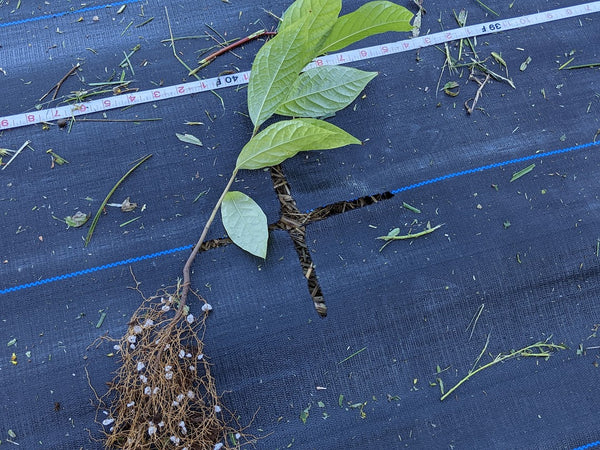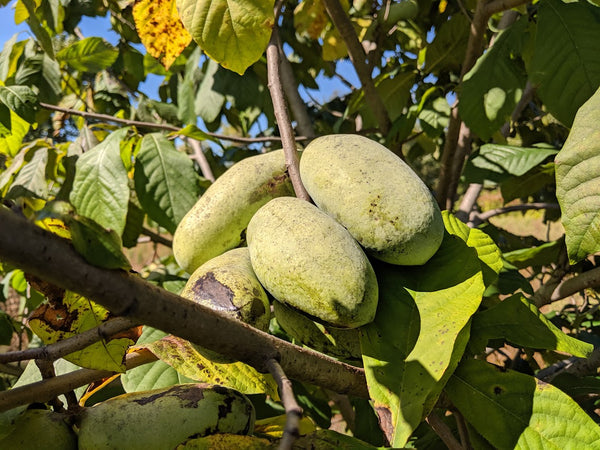How to grow Pawpaw from seed
•Posted on жовтень 26 2022


How to grow Pawpaw from seed
Pawpaw is a unique, uncommon, and lovely autumn fruit that everyone should try at least once. The trees are an understory shade plant, with a floppy–leafed canopy, slow–growing and deciduous. The trees can be found along creeks and in valleys throughout the eastern USA, and luckily for us, pawpaw is also native to southern Ontario and Quebec. With what tastes like a tropical fruit, pawpaw seems almost out of place as far north as Canada. If you want to read up on common pawpaw visit this blog to learn the basics about this wild fruit!


Seed care
To process seeds, slice the pawpaw fruit lengthwise and remove the seeds. You will notice a membrane surrounding each seed that attaches its base. You can peel this away or leave it attached, but leaving the membrane intact will lead to mold growth in the storage/stratification stage. The mold will not harm the seeds but may be off-putting to work with. Using a knife, separate the membrane and pop out the seed, then place it in a damp paper towel or your preferred substrate.


Storing seeds
Planting pawpaw requires that seeds be stratified for 80 to 120 days. We store our seeds in a sealed ziplock bag with damp paper towel in the fridge from October until February. Alternatively, you could place seeds in a moist lidded tray filled with sand and vermiculite. Starting seeds in February inside gives the trees ample time to germinate before spring and extends their first growing season. It is important that seeds remain moist and at no point are left to dry out before being stored or germinated. Seeds that have been frozen may germinate, however freezing can significantly reduce the amount of viable seeds.

Starting Seeds
In February, when the seeds have been removed from stratification, lightly score them along their seam and, leaving them in or moving them to a lidded tray, cover lightly with a sand and vermiculite mix, triple mix, or potting soil. If your seeds are moldy give them a rinse; the mold will not harm them. The pawpaw seeds will begin to germinate at around 16°C ( 60.8°F ) after about three weeks. However, the unpredictable nature of germination means that three weeks could stretch to three months. Don't get discouraged if they don't show signs of life in March or April. Roots will eventually emerge! 
Planting temporary pots
When your pawpaw seeds have begun to sprout, plant them just below the surface of loosely packed tall pots, 10 inches deep minimum. ( One litre milk cartons with holes punched in the bottom work okay .) We use tree pots imported from the US that are open at the base and will allow the roots to protrude from the bottom. I've seen people use stapled, cut up yoga mats and poster tubes cut into 12-in lengths. The seed will shoot down a long tap root before it does much above the soil. You want to give the tap root plenty of room to avoid growing into a J-root and causing issues such as stunted growth or sudden loss of the tree later on.

While fruit trees can really be planted whenever you can work the soil, to give your pawpaws their best start, plant them either in early spring, before you see any leaves forming, or in mid fall when trees start to change colour and lose their leaves. This will reduce stress on the trees as any leaf that starts off in sheltered or greenhouse conditions will not be as tolerant of the sun as a leaf that grew in sunny conditions. If you start your seeds in February inside, your first-year growth will not be accustomed to the sun. You will want to keep them shaded or behind glass for the first year and plant them any time after mid September to early November. This autumn planting will give them time before they go dormant to shoot down roots while they lose their leaves, avoiding the brightest and heaviest sunny conditions of summer that can scorch them.


Your pawpaw's forever home
Now that you have a sprouted pawpaw growing happily in a tree pot or milk carton, you will want to find a forever location for your tree, either before it goes dormant after its first year of growth or in the early spring while it is still dormant. Because pawpaws put down deep tap roots, replanting them is difficult and could cause permanent damage to the trees. So wherever you put them should be suitable for them to live permanently. Keeping in mind that the tap root drives growth, planting them in super rocky soil and places where they would compete with other tree roots will slow or hamper their growth rate. Find a location with rich slightly acidic soil that has good drainage and few other plants competing for resources.


How to plant
How you plant pawpaw can have a significant effect on how quickly they grow. While factors such as genetics and soil conditions will dictate growth rates to an extent, some simple procedures can really help start them off on the right track. Dig twice as deep as you need to accommodate the tap root. This will let you know if there are any obstructions under the tree that might interfere with growth. It will also loosen the soil, making it easier for the roots to grow downward. A small handful of blood meal or bone meal can help stimulate root growth and give the tree a little boost, the addition of chemical fertilizers may stunt growth or burn the young trees, so keep it simple.
After planting, surround the pawpaw with mulch, making sure not to pile it up around the stem or trunk of the tree, as that can lead to mold and pest issues. If you are planting trees in spring and or summer that are already in leaf, some shade cloth may come in handy as trees that are not accustomed to direct sun may scorch. If the trees are already habituated to sunny conditions, the shade cloth is optional. Many people advise you give the trees some shade during their first few years of growth, however it is possible to growth them in full sun, as long as they get ample water.


Winter Care
Pawpaws don't need special attention when it comes to winterizing them, but young trees can always benefit from mulch, raised shade cloth and deer fencing; however wrapping trees in burlap may result in rodent damage, so it's not advised. Pawpaw is hardy in zones 6 and 7 and they can survive in zones as cold as 5a or 5b and perhaps even 4. There are fruiting pawpaw trees as far north as Ottawa, Ontario, and it is entirely possible that global warming will extend their habitable range farther. Pawpaw trees can generally resist colds down to -30°C or -22°F.

Organic milk-based paint applied to the south-facing side of a small tree can help prevent trees from cracking in the winter sun. As the sun warms the tree trunk, it can cause sap to flow out of season, resulting in cracks and breaks in the bark that can lead to stress that will later affect the health of the tree and the amount of fruit it produces. If your plants are already shaded from winter sun, this is less of an issue.

The best way to get your hands on some seeds is to find ripe pawpaws. There are also a few places online that will have them, or you can always ask us at Forbes Wild Foods shortly after pawpaw season if we have any fruit left. While not true-to-parent, pawpaws will have many of the same features of their parent trees; fruit flavour, size and hardiness may all be passed down, so there is a good chance that if you enjoyed the fruit you got your seeds from, your trees will produce the same wonderful pawpaw fruit themselves.
Buy pawpaw seeds here
More Posts
-
Get to know the mos...
Autumn is the absolute best time for mushrooms, after a year of growth the cool nights trigger mycelium to shoot out new fruiting bodies and the fo...
Read More



Comments
14 Comments
-

Posted by Mark Steedly | December 10, 2025
-

Posted by Cody Hunt | December 19, 2024
-

Posted by Suelyn Bartz | October 29, 2024
-

Posted by Niamke | September 24, 2024
-

Posted by Rob | September 24, 2024
-

Posted by Eileen | September 24, 2024
-

Posted by JJ | September 24, 2024
-

Posted by Togun Oluwashindara | September 24, 2024
-

Posted by Alex | September 24, 2024
-

Posted by Joannie | September 24, 2024
-

Posted by Susan | September 24, 2024
-

Posted by Hansel de Sousa | December 02, 2022
-

Posted by Ap | November 01, 2022
-

Posted by Liz Crawford | October 26, 2022
Leave a CommentIs it mandatory to score the seeds before planting? I did not, but I wonder if I should have.
Howdy! I have a self pollinating ‘Shenandoah’ Peterson pawpaw. Same situation as Suelyn, two trees and the other ‘Shenandoah’ has never flowered. I’m in Bellingham WA so there’s no native pawpaw here and no one in my neighborhood has pawpaws. I finally got my first real harvest this year (~60 fruits, some are quite large) and I can tell you the taste and sugar content is amazing. I have no other experience with pawpaws but a friend who visited KSU and several pawpaw festivals last year said my fruits are right up there with the ones she had last year.
I bought two named varieties many years ago. Only one tree has ever produced flowers and I have been getting good crops from it for many years. Initially I was under the impression that I needed two trees for fruit, but my “Pennsylvania Golden” pawpaw proved that isn’t true.
Do y’all have any pawpaw cultivars for sale? specifically germ plasm or seed material?
I am wondering how the fruit turned out. I hear there is a slim chance to get good tasting edible fruit from pawpaws started from seed.
I have heard that it’s not about the sex of the flowers, but that you need two trees that are not both offspring of the same parent. Nurseries sell plants in pairs from seeds of different trees.
The two older comments, I think are actually about papaya, which is called pawpaw in some locations. The pawpaw that grow in Canada do not have separate male and female flowers. I know because I have some trees and I pollinate them by hand (although the flies do it, too).
Thank you (Ma/Sir),for the idea and information. I will gladly try this at home. Also I would love to know how many seeds are to be planted?
You’re both wrong. Paw paw have all 3. Male, female, and hermaphrodite.
I wonder if the winter sowing method would prove effective for paw paw seeds. I’m in RI.
AS seen in this article: "Pawpaw is self-incompatible, which means that pollen produced on a plant cannot pollinate flowers on the same plant. Instead, to produce fruit, a pawpaw flower must receive pollen from flowers on another tree, and sometimes this “other tree” is farther away than it may appear at first glance! Although pawpaws frequently grow in clusters (think pawpaw patch), the trees in a patch are often genetically identical and connected underground by roots (and thus, in biological terms, are a single plant). Nonetheless, pawpaw’s pollinators (which include flies and beetles) inevitably pollinate some flowers, and fruit-hunters may eventually find a tree with fruit. "
https://www.nps.gov/articles/pawpaw.htm?fbclid=IwAR0vKyC7NPgg_oHeRh7MZJQyD1uOI3qkzcunNHrNbhUwbphbCyP8ptiICJI
The previous two comments are not correct. Pawpaw trees are not either male or female and the flowers are not trioecious. All trees produce flowers that all initially behave as female and then later produce pollen. Pawpaw flowers can be said to be Bisexual, Perfect, Androgynous, Hermaphroditic, Monoclinous, Synoecious, Dichogamous and Protogynous.
https://en.wikipedia.org/wiki/Plant_reproductive_morphology
You need two trees for cross pollination that’s it.Pawpaw trees can be fickle with regards to what sex the flowers are. Pawpaw flowers are termed trioecious (subdioecious), which means they have separate male, female as well as hermaphroditic plants
You need a male and female tree to get fruit and you can’t tell if a tree is male or female until they flower so best to plant 3 or 4 trees. Trees also need to be within 3m of each to pollinate.